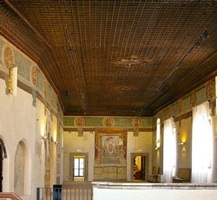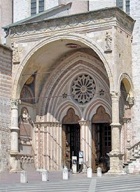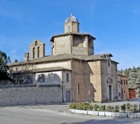Francesco di Bartolomeo da Pietrasanta, who was probably born in Pietrasanta in Tuscany, moved to Foligno. He was first documented there in 1477, when he was in charge of the work underway in Palazzo Apostolico (ex Palazzo Trinci), and it seems likely that he had been sent there from Rome by Pope Sixtus IV. He became one of the most active architects in Foligno. He returned to Rome in 1478-9 to work in the church of Santa Maria del Popolo.
Pope Alexander IV sold Gualdo Cattaneo to Foligno in 1493. The Commune commissioned a design from Francesco da Pietrasanta for a new fortress there, which formed part of a defensive system along Foligno’s borders with Perugia and Todi. Francesco da Pietrasanta delivered the designs in June 1494. He was murdered, apparently by exiles from Gualdo Cattaneo two months later. (The Rocca di Gualdo Cattaneo was completed in 1498).
Foligno
Work in Palazzo Apostolico (1477-8)

Francesco da Pietrasanta is documented as the director of work at Palazzo Apostolico (ex Palazzo Trinci) in 1477-8. His work here probably included the remodelling of the Sala di Sisto IV on the piano nobile: this had originally been an open terrace overlooking the inner courtyard, but was enclosed in a restoration that followed an earthquake in 1477. The sculpted arms at the centre of the ceiling belonged to:
-
✴Pope Sixtus IV; and
-
✴Cardinal Giovanni Battista Savelli, who was papal legate in 1480-2.
Work in San Domenico (1478)
In 1478, the friars of San Domenico retained Francesco da Pietrasanta to rebuild the tribune of the church. A few months later, he was commissioned to build the left apsidal chapel, which was to be identical to the chapel that already existed to the right of the apse.
Restoration of Palazzo dei Priori (1479)
Francesco da Pietrasanta was commissioned to restore Palazzo dei Priori in 1479.
Work in San Giacomo (1484-7)
In 1484, the friars of San Giacomo retained Francesco da Pietrasanta to begin the remodelling of the church, which involved the design of a new campanile and of a cupola above the crossing. He was also required to build a new high altar in the crossing, similar to that in Santa Maria del Popolo, Rome. The contract for the completion of this work was signed in 1487.
Francesco da Pietrasanta also received private commissions in the church for the construction of:
-
✴the Cappella di San Rocco (in 1486); and
-
✴the Cappella di Santa Lucia (in 1487).
Oratorio della Nunziatella (1494)
The design of the Oratorio della Nunziatella is attributed to Francesco da Pietrasanta.
Assisi
Porch of the Lower Church of San Francesco (1487)

Spoleto
Santa Maria del Massaccio (1490-2)

Trevi
Madonna delle Lacrime (1487-1514)




